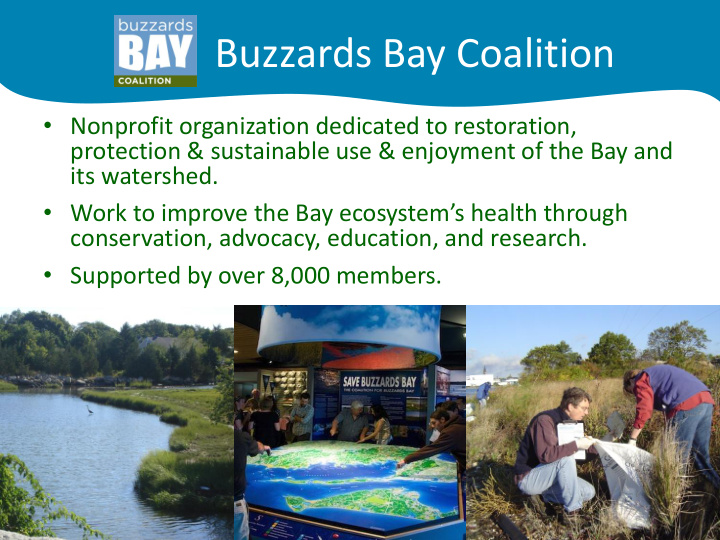



Buzzards Bay Coalition • Nonprofit organization dedicated to restoration, protection & sustainable use & enjoyment of the Bay and its watershed. • Work to improve the Bay ecosystem’s health through conservation, advocacy, education, and research. • Supported by over 8,000 members. Photo: Robert Manz
Why Create Baywatchers Program? • 1992 Comprehensive Management Plan for Buzzards Bay identifies Nitrogen Pollution as greatest long-term threat to Bay. While nutrient problems well documented elsewhere (ie. Chesapeake Bay, Baltic Sea), extent of the problem in Buzzards Bay was unknown. • BBC realized that no one – communities, state and federal agencies, scientists, etc – would be able to do anything about the nitrogen problem without information and the ability to track trends over time. How would anyone know what to focus on, how would we see if we were making progress, etc.? • No examples existed at the time to help create a program to cover such a large area over time at low cost. BBC with support from Woods Hole Oceanographic Institution had to invent. Guiding Goal: A well-coordinated citizen effort, with good technical and managerial oversight, will not only produce good quality information that is useful for government, but will also increase citizen awareness of local environmental degradation.
Baywatchers Monitoring Program • Basic water quality testing (DO, temp, salinity, secchi) performed every ~5 days from June to Sept • Nutrient and algae samples collected 4 times a summer and analyzed by Marine Biological Lab Ecosystems Center (under 10 yr contract to BBC). • ~200 stations in 30 harbors & coves • Coalition staff train ~130 volunteers. >700 people since 1992. • Largest monitoring effort in MA, cover ¼ of coast • Methods approved by EPA and DEP
Baywatchers Program Growth From its creation in 1992, Baywatchers has grown to annually engage 130 volunteers who cover 175 sampling locations.
Bay Health Index • Key monitoring parameters are combined to produce a Bay Health Index score on a scale of 0 to 100 – Dissolved oxygen saturation – Secchi disk depth – Total algal pigments – Total Organic Nitrogen – Dissolved Inorganic Nitrogen
Calculating the Bay Health Index Annual averages of 5 parameters are combined to produce a Bay Health Index score from 0 to 100: Parameter 0 points 100 points 40% sat 90% sat DO (lowest 20% of measmts) 0.6 m 3 m Secchi disk depth 10 ug L -1 3 ug L -1 Chla + pheo 10 uM 1 uM DIN (0.14 ppm) (0.014 ppm) 43 uM 20 uM TON (0.6 ppm) (0.28 ppm)
Index plots Decline in Bay Health
Examples of what the data can show Water quality Water quality declines improvements after action with no action
Data Uses: Documents Effect of reducing N
Data Uses: Water Quality in a Warming World
Data Uses: Trend analysis of Temp over time Average July Temperature: 1992 – 2002: 22.6 °C or 72.6 °F 2003 – 2013: 23.1 °C or 73.6 °F
Strengths of Baywatchers • Continuous long term record (23 yrs) • Volunteers allow large spatial coverage at relatively low cost • Renowned scientific institution as partner • Data has been accepted by EPA/DEP for regulatory use in pollution permitting and management.
Baywatchers Budget & Funding
Baywatchers Monitoring Plan
Baywatchers QAPP - Contents Table of Contents: Baywatchers, Quality Assurance Project Plan (QAPP) A PROJECT MANAGEMENT A.1. Title and Approval Page A.2. Table of Contents: Baywatchers, Quality Assurance Project Plan .................................................................................... 3 A.3. Distribution List ................................................................................................................................................................. 4 A.4. Project Organization and Responsibilities ......................................................................................................................... 5 A.5. Project Background and Introduction ................................................................................................................................ 7 A.6. Project Task Description ................................................................................................................................................... 9 A.7. Data Quality Objectives .................................................................................................................................................. 14 A.8. Training certification ...................................................................................................................................................... 18 A.9. Documentation and Records ......................................................................................................................................... ..19 B. MEASUREMENT/DATA ACQUISITION ................................................................................................................... 21 B.1. Sampling Process Design ............................................................................................................................................... .21 Parameters Analyzed and Data Quality Requirements and Assessments .............................................................................. 22 B.2. Sampling Methods Requirements.................................................................................................................................... 24 B.3. Sample Handling Requirements .................................................................................................................................... .24 B.4. & B.5. Analytical Methods Requirements / Quality Control Requirements .................................................................. 25 B.6. & B.7. Calibration Procedures and Preventive Maintenance for Field Equipment ....................................................... 28 B.8. Acceptance Requirements .............................................................................................................................................. 29 B.9. Data Acquisition Requirements ..................................................................................................................................... 30 B.10. Data Management ........................................................................................................................................................ 30 C. ASSESSMENT AND OVERSIGHT .............................................................................................................................. 32 C.1. Assessment and Response Actions ................................................................................................................................ 32 C.2. Reports ........................................................................................................................................................................... 32 D. DATA VALIDATION AND USABILITY ................................................................................................................... 33 D.1 Data Review, Validation / Usage ................................................................................................................................... 33 D.2 Data Review, Validation ................................................................................................................................................ 34 D.3. Reconciliation with Data Quality Objectives ................................................................................................................ 36
Recommend
More recommend